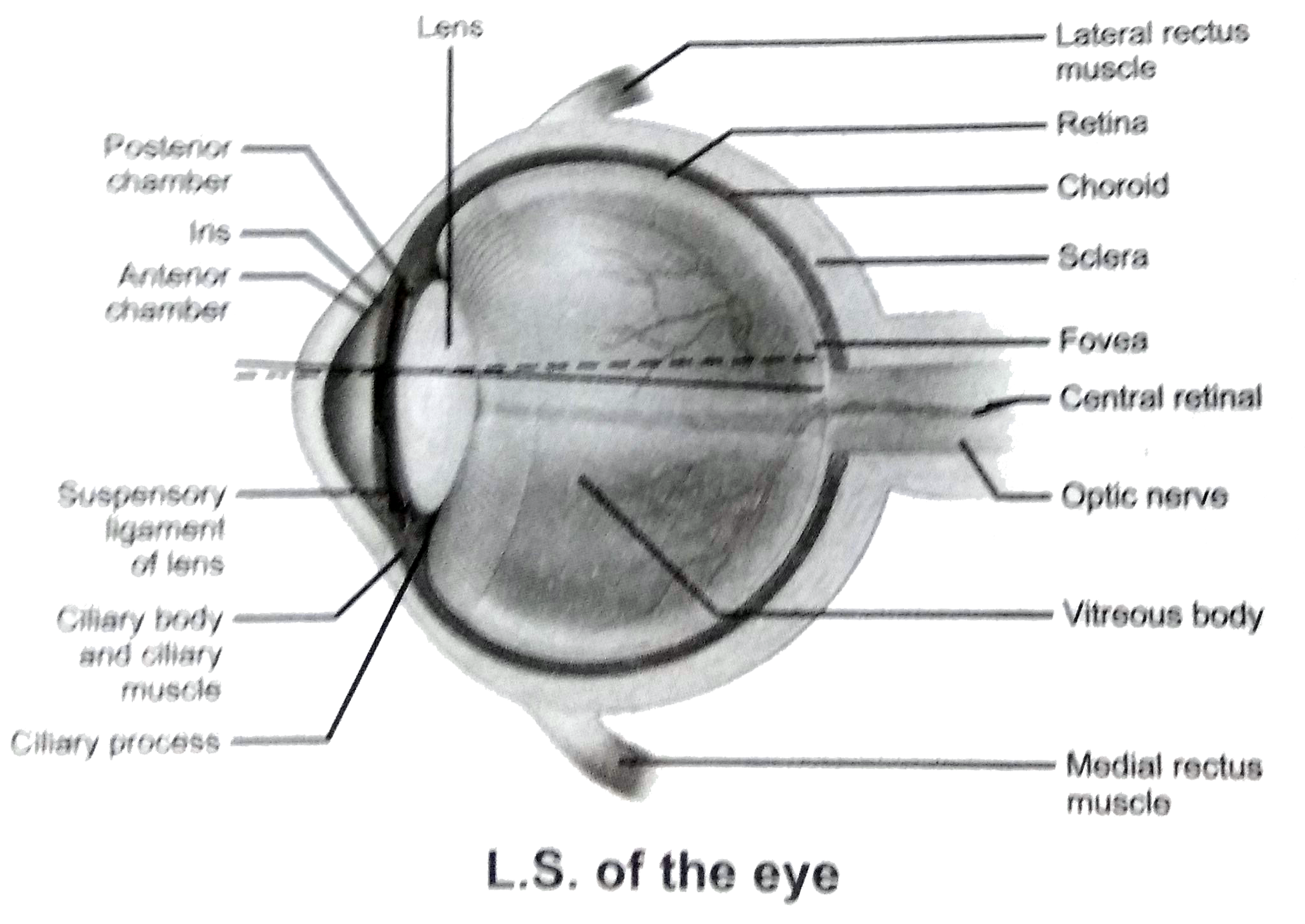Explain the structure of Photoreceptor.Solution in Tamil
Eye is the organ of vision: located in the orbit of the skull and held in its position with the help of six extrinsic muscles. They are superior, inferior, lateral, median rectus muscles, superior oblique and inferior oblique muscles. These muscles aid in movement of the eyes and they receive their nerve innervation from III, IV and VI cranial nerves. Eyelids, eye lashes and eye brows are the accessory structures useful in protecting the eyes. The eye lids protect the eyes from excessive light and foreign objects and spread lubricating secretions over the eyeballs. Eyelashes and the eyebrows help to protect the eyeballs from foreign objects, perspiration and also from the direct rays of sunlight. Sebaceous glands at the base of the eyelashes are called ciliary glands which secrete a lubricating fluid into the hair follicles. Lacrymal glands, located in the upper lateral region of each orbit, secrete tears. Tears are secreted at the rate of 1 ml/day and it contains salts, mucus and lysozyme enzyme to destroy bacteria. The conjunctiva is a thin, protective mucous membrane found lining the outer surface of the eyeball.
The eye has two compartments, the anterior and posterior compartments. The anterior compartment has two chambers, first one lies between the cornea and iris and the second one lies between the iris and lens. These two chambers are filled with watery fluid called aqueous humor. The posterior compartment lies between the lens and retina and it is filled with a jelly like fluid called vitreous humor that helps to retain the spherical nature of the eve. Eve lens is transparent and biconvex, made up of long columnar epithelial cells called lens fibres. These cells are accumulated with the proteins called crystalline.
The eye ball is spherical in nature. The anterior one- sixth of the eyeball is exposed, the remaining region is fitted well into the orbit. The wall of the eye ball consists of three layers: fibrous Sclera, vascular Choroid and sensory Retina.
The outer coat is composed of dense non-vascular connective tissue. It has two regions: the anterior cornea and the posterior sclera. Cornea is a non-vascular transparent coat formed of stratified squamous epithelium which helps the cornea to renew continuously as it is very vulnerable to damage from dust. Sclera forms the white of the eye and protects the eyeball. Posteriorly the sclera is innervated by the optic nerve. At the junction of the sclera and the cornea is a channel called 'canal of schlemm' which continuously drains out the excess of aqueous humor.
Choroid is highly vascularized pigmented layer that nourishes all the eye layers and its pigments absorb light to prevent internal reflection.
Anteriorly the choroid thickens to form the ciliary body and iris. Iris is the coloured portion of the eye lying between the cornea and lens. The aperture at the centre of the iris is the pupil through which the light enters the inner chamber. Iris is made of two types of muscles the dilator papillae (the radial muscle) and the sphincter papillae (the circular muscle). In the bright light, the circular muscle in the iris contract, so that the size of pupil decreases and less light enters the eye. In dim light, the radial muscle in the iris contract, so that the pupil size increases and more light enters the eye. Smooth muscle present in the ciliary body is called the ciliary muscle which alters the convexity of the lens for near and far vision. The ability of the eyes to focus objects at varying distances is called accommodation which is achieved by suspensory ligament, ciliary muscle and ciliary body. The suspensory ligament extends from the ciliary body and helps to hold the lens in its upright position. The ciliary body is provided with blood capillaries that secrete a watery fluid called aqueous humor that fills the anterior chamber.
Retina forms the inner most layer of the eye and it contains two regions: A sheet of pigmented epithelium (non visual part) and neural visual regions. The neural retina layer contains three types of cells: photoreceptor cells - cones and rods, bipolar cells and ganglion cells. The yellow flat spot at the centre of the posterior region of the retina is called macula lutea which is responsible for sharp detailed vision.
A small depression present in the centre of the yellow spot is called fovea centralis which contains only cones. The optic nerves and the retinal blood vessels enter the eye slightly below the posterior pole, which is devoid of photo receptors, hence this region is called blind spot.

Topper's Solved these Questions
- NEURAL CONTROL AND COORDINATIONBOOK - FULL MARKSCHAPTER - NEURAL CONTROL AND COORDINATIONEXERCISE - ADDITIONAL QUESTIONS SOLVED (Short Answer Questions)
40 Videos
- MINERAL NUTRITIONBOOK - FULL MARKSCHAPTER - MINERAL NUTRITIONEXERCISE - ADDITIONAL QUESTIONS SOLVED - MULTIPLE CHOICE QUESTIONS
5 Videos
- ORGAN AND ORGAN SYSTEMS IN ANIMALS BOOK - FULL MARKSCHAPTER - ORGAN AND ORGAN SYSTEMS IN ANIMALS EXERCISE - ADDITIONAL QUESTIONS SOLVED (III Answer the following Questions)
35 Videos
Similar Questions
What are neurons? What are their functions.
View SolutionCarnivorous plants like Nepenthes and Venus fly trap have nutritional adaptation. Which nutrients do they especially obtain and from where?
View SolutionClassify earthworms based on their ecological strategies.
View SolutionPhotoreceptors (phaosomes) in earthworm occur in
View SolutionPhotoreceptors earthworm occur in
View SolutionPhotoreceptors in earthworms occur in
View SolutionPhotoreceptor cells are present in ……………………
View SolutionIn sense organ photoreceptors are
View SolutionThe photoreceptors of cockroach are
View SolutionHuman Eye (Photoreceptor) Introduction Extra-Occular Muscles Protective Structures OF Eye
View SolutionName the photoreceptor cells of eye.
View SolutionPhotoreceptors (phaosomes) in earthworm occur in
View SolutionPhotoreceptors in Pheretima are present
View SolutionWrite the note on photoreceptor cells.
View SolutionWhere are photoreceptor cells located?
View Solution
